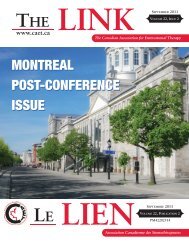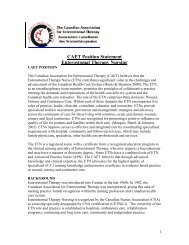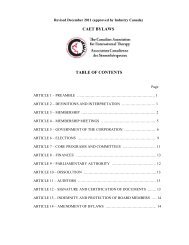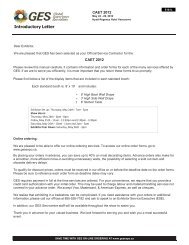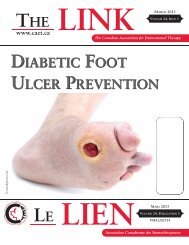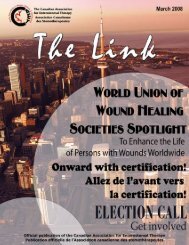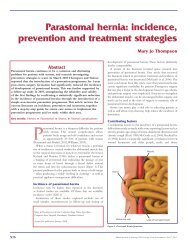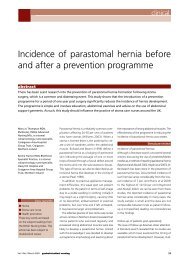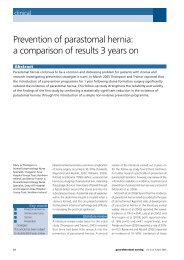Enterostomal Therapy Nursing in the Canadian Home Care Sector
Enterostomal Therapy Nursing in the Canadian Home Care Sector
Enterostomal Therapy Nursing in the Canadian Home Care Sector
You also want an ePaper? Increase the reach of your titles
YUMPU automatically turns print PDFs into web optimized ePapers that Google loves.
WON200104.qxp 1/5/10 8:42 AM Page 53<br />
J Wound Ostomy Cont<strong>in</strong>ence Nurs. 2010;37(1):53-64.<br />
Published by Lipp<strong>in</strong>cott Williams & Wilk<strong>in</strong>s<br />
OSTOMY CARE<br />
<strong>Enterostomal</strong> <strong>Therapy</strong> <strong>Nurs<strong>in</strong>g</strong> <strong>in</strong><br />
<strong>the</strong> <strong>Canadian</strong> <strong>Home</strong> <strong>Care</strong> <strong>Sector</strong><br />
What Is Its Value<br />
L<strong>in</strong>da Baich Donna Wilson Greta G. Cumm<strong>in</strong>gs<br />
Approximately one-third of all home care patients have wound<br />
care needs. <strong>Home</strong> care patients tend to be older and have<br />
multiple chronic diseases render<strong>in</strong>g <strong>the</strong>m at risk for develop<strong>in</strong>g<br />
wounds and impair<strong>in</strong>g <strong>the</strong>ir ability to heal wounds.<br />
<strong>Enterostomal</strong> <strong>the</strong>rapy (ET) nurses have expertise <strong>in</strong> wound,<br />
ostomy, and cont<strong>in</strong>ence care, and were recently recognized by<br />
<strong>the</strong> <strong>Canadian</strong> Nurses Association as a specialty practice. We<br />
completed a systematic review <strong>in</strong> order to identify and syn<strong>the</strong>size<br />
evidence about <strong>the</strong> value of ET nurses <strong>in</strong> <strong>the</strong> <strong>Canadian</strong><br />
home care sector, focus<strong>in</strong>g on wound care. A literature search<br />
was conducted, us<strong>in</strong>g 9 computerized library databases. Eight<br />
articles were identified for review; each was analyzed us<strong>in</strong>g<br />
qualitative content analysis. Two <strong>the</strong>mes emerged from our<br />
analysis: (1) assess<strong>in</strong>g <strong>the</strong> outcomes of ET nurse <strong>in</strong>volvement <strong>in</strong><br />
client care and (2) methods for us<strong>in</strong>g ET nurses’ expertise.<br />
With<strong>in</strong> <strong>the</strong>se <strong>the</strong>mes, <strong>the</strong> benefits of ET nurses work<strong>in</strong>g <strong>in</strong><br />
home care were identified: (1) a decreased number of visits,<br />
(2) reduced wound-heal<strong>in</strong>g times, (3) successful heal<strong>in</strong>g,<br />
(4) reduced cost of wound care, (5) greater support for nurses<br />
and families, (6) fewer emergency department visits, (7) fewer<br />
hospital readmissions, (8) <strong>in</strong>creased <strong>in</strong>terest <strong>in</strong> education <strong>in</strong><br />
wound care among o<strong>the</strong>r nurses, and (9) standardized<br />
protocols for wound care. Although only 8 studies were located<br />
for this review, <strong>the</strong>ir f<strong>in</strong>d<strong>in</strong>gs provide evidence that ET nurses’<br />
contributions to wound care are not only positive but also<br />
necessary <strong>in</strong> <strong>the</strong> home care sector.<br />
■ Introduction<br />
<strong>Home</strong> care nurses are generalists who care for patients<br />
with a wide range of disorders. 1,2 Patient assignments are<br />
typically distributed over a geographical area, 1,2 requir<strong>in</strong>g<br />
<strong>the</strong>m to travel to homes with<strong>in</strong> <strong>the</strong>ir assigned region. In<br />
<strong>the</strong> <strong>Canadian</strong> healthcare system, a home care nurse provides<br />
care for as many as 70 or more patients at a given<br />
time, depend<strong>in</strong>g on <strong>the</strong> need and complexity of each case.<br />
Registered nurses often provide case management, which<br />
<strong>in</strong>cludes organiz<strong>in</strong>g services for patients via referrals to a<br />
variety of professionals and nonprofessionals such as<br />
healthcare aides or homemakers.<br />
The demand for home care nurs<strong>in</strong>g has <strong>in</strong>creased <strong>in</strong> recent<br />
years, partly because of fiscal restra<strong>in</strong>ts on <strong>the</strong> healthcare<br />
system imposed <strong>in</strong> <strong>the</strong> 1990s. 3 In <strong>the</strong> prov<strong>in</strong>ce of<br />
Alberta, <strong>the</strong> number of home care patients doubled between<br />
1991 and 2001. 4 Technological advances and <strong>the</strong><br />
wish to be at home have also <strong>in</strong>fluenced care, result<strong>in</strong>g <strong>in</strong><br />
shorter hospital stays and shift<strong>in</strong>g diagnostic tests and<br />
treatments to an outpatient basis. 5 Early hospital discharge,<br />
and an <strong>in</strong>crease <strong>in</strong> <strong>the</strong> number of frail-elders liv<strong>in</strong>g<br />
at home, has contributed to <strong>the</strong> <strong>in</strong>creased grow<strong>in</strong>g population<br />
of high-acuity home care patients. 3<br />
The prevalence of chronic disease is <strong>in</strong>creas<strong>in</strong>g as a result<br />
of multiple factors such as advanced age, obesity, longterm<br />
exposure to environmental tox<strong>in</strong>s, and <strong>the</strong> availability<br />
of treatments that save lives but do not cure <strong>the</strong> underly<strong>in</strong>g<br />
illness. 6 Chronic disease and ag<strong>in</strong>g <strong>in</strong>crease <strong>the</strong> risk of develop<strong>in</strong>g<br />
wounds and impair <strong>the</strong> wound-heal<strong>in</strong>g process. 7<br />
The majority of patients with established wounds are now<br />
treated <strong>in</strong> <strong>the</strong>ir home ra<strong>the</strong>r than <strong>in</strong> hospital. 8 This standard<br />
of management differs from earlier care delivery patterns<br />
when only one-third of all wound care patients were receiv<strong>in</strong>g<br />
wound care through a home care program. 2,9-11<br />
Advances <strong>in</strong> wound care knowledge and technologies<br />
have resulted <strong>in</strong> an escalation <strong>in</strong> <strong>the</strong> number of available<br />
wound care products, <strong>in</strong>clud<strong>in</strong>g many that have very specific<br />
<strong>in</strong>dications for use. In <strong>the</strong> <strong>Canadian</strong> healthcare system,<br />
generalist home care nurses do not have <strong>the</strong> advanced<br />
tra<strong>in</strong><strong>in</strong>g needed to manage complicated wounds. Instead,<br />
we advocate that ET nurses should be required to provide<br />
L<strong>in</strong>da Baich, MN, RN, Instructor, Red Deer College, Red Deer,<br />
Alberta, Canada.<br />
Donna Wilson, PhD, RN, Professor & Caritas Nurse Scientist, Faculty<br />
of <strong>Nurs<strong>in</strong>g</strong>, University of Alberta, Edmonton, Alberta, Canada.<br />
Greta G. Cumm<strong>in</strong>gs, PhD, RN, Associate Professor, Faculty of<br />
<strong>Nurs<strong>in</strong>g</strong>, University of Alberta, Edmonton, Alberta, Canada.<br />
Correspond<strong>in</strong>g author: L<strong>in</strong>da Baich, MN, RN, 5312-38 St, Rocky<br />
Mounta<strong>in</strong> House, Alberta, Canada AB T4T 1V5 (lbaich@ualberta.ca).<br />
Editor’s Note: As noted by <strong>the</strong> authors, <strong>the</strong> <strong>Canadian</strong> Nurses<br />
Association has recently recognized wound, ostomy and cont<strong>in</strong>ence<br />
nurs<strong>in</strong>g as a specialty nurs<strong>in</strong>g practice. In Canada, <strong>the</strong> official designation<br />
is ET Nurse. That designation has been preserved <strong>in</strong> this article.<br />
Copyright © 2010 by <strong>the</strong> Wound, Ostomy and Cont<strong>in</strong>ence Nurses Society J WOCN ■ January/February 2010 53
WON200104.qxp 1/5/10 8:42 AM Page 54<br />
54 Baich et al J WOCN ■ January/February 2010<br />
this level of care. Never<strong>the</strong>less, we also recognize that <strong>the</strong><br />
care offered by ET nurses is costly when compared to that<br />
by nurs<strong>in</strong>g aides or licensed practical nurses, especially <strong>in</strong><br />
<strong>the</strong> home care sector. In addition, ET home care nurses are<br />
rare <strong>in</strong> <strong>the</strong> <strong>Canadian</strong> healthcare system, so determ<strong>in</strong><strong>in</strong>g<br />
<strong>the</strong>ir value <strong>in</strong> <strong>the</strong> home care sector is important. In order<br />
to evaluate <strong>the</strong> accumulated evidence on <strong>the</strong> value of ET<br />
nurs<strong>in</strong>g <strong>in</strong> <strong>the</strong> <strong>Canadian</strong> home care sector, we conducted a<br />
systematic review of published, peer-reviewed research literature<br />
focus<strong>in</strong>g on ET nurs<strong>in</strong>g care of wounds.<br />
■ Operational Def<strong>in</strong>itions<br />
ET Nurse<br />
In <strong>the</strong> <strong>Canadian</strong> healthcare system, ET nurse is <strong>the</strong> term<br />
used for baccalaureate-prepared registered nurses who<br />
have also completed a postgraduate program from a<br />
recognized ET nurse education provider. This preparation<br />
results <strong>in</strong> a specialized body of knowledge <strong>in</strong> wound,<br />
ostomy, and cont<strong>in</strong>ence management. Certification for ET<br />
nurses has recently been approved by <strong>the</strong> <strong>Canadian</strong> Nurses<br />
Association, us<strong>in</strong>g <strong>the</strong> designation of CETN(C). In <strong>the</strong><br />
United States, this specialty practice is called WOC<br />
nurs<strong>in</strong>g. 12<br />
<strong>Canadian</strong> <strong>Home</strong> <strong>Care</strong> <strong>Sector</strong><br />
The home care sector is <strong>the</strong> sett<strong>in</strong>g <strong>in</strong> which nurs<strong>in</strong>g services<br />
are delivered to patients who are nei<strong>the</strong>r <strong>in</strong> hospital<br />
nor liv<strong>in</strong>g <strong>in</strong> a cont<strong>in</strong>u<strong>in</strong>g care facility. <strong>Home</strong>s <strong>in</strong>clude private<br />
dwell<strong>in</strong>gs where <strong>the</strong> patient lives alone or with o<strong>the</strong>rs<br />
such as family members or caregivers. In 2007, <strong>the</strong><br />
<strong>Canadian</strong> <strong>Home</strong> <strong>Care</strong> Association def<strong>in</strong>ed home care as<br />
“array of services, provided <strong>in</strong> <strong>the</strong> home and community<br />
sett<strong>in</strong>g, that encompass health promotion and teach<strong>in</strong>g,<br />
curative <strong>in</strong>tervention, end-of-life care, rehabilitation, support<br />
and ma<strong>in</strong>tenance, social adaptation and <strong>in</strong>tegration,<br />
and support for <strong>the</strong> <strong>in</strong>formal (family) caregiver.” 13(p1)<br />
<strong>Home</strong> care programs <strong>in</strong>tegrate <strong>the</strong> delivery of healthcare<br />
services <strong>in</strong> <strong>the</strong> home sett<strong>in</strong>g with community services such<br />
as meals on wheels, day programs, respite care facilities,<br />
volunteer services, and transportation services.<br />
Value of ET <strong>Nurs<strong>in</strong>g</strong><br />
We def<strong>in</strong>ed <strong>the</strong> value of ET nurs<strong>in</strong>g as <strong>the</strong> positive or negative<br />
outcomes of ET nurs<strong>in</strong>g <strong>in</strong> <strong>the</strong> home care sector as<br />
compared to services provided by a generalist home care<br />
nurse. This value may <strong>in</strong>clude direct cost <strong>in</strong>creases or sav<strong>in</strong>gs,<br />
quality of life for <strong>the</strong> patients, provision of education<br />
for healthcare providers and patients, changes <strong>in</strong> health<br />
policy, improved self-care, or improved case management<br />
for <strong>the</strong> patients.<br />
Methods<br />
The follow<strong>in</strong>g question guided <strong>the</strong> review and search strategy<br />
for this systematic review: “What is <strong>the</strong> value of ET<br />
nurs<strong>in</strong>g <strong>in</strong> <strong>the</strong> home care sector” The search strategy<br />
began with a search of 9 computerized library databases<br />
(CINAHL, MEDLINE, Health Source, Global Health,<br />
PubMed, AgeL<strong>in</strong>e, Cochrane, Web of Science, and Scopus).<br />
All <strong>in</strong>dexed years <strong>in</strong> each electronic database were<br />
searched. Librarians at <strong>the</strong> University of Alberta assisted <strong>in</strong><br />
select<strong>in</strong>g and search<strong>in</strong>g <strong>the</strong>se databases. Gray and colleagues<br />
expla<strong>in</strong>ed that “databases search <strong>the</strong> available articles<br />
or entries based on specific words or phrases, called<br />
key words.” 14(p54) The key words/terms <strong>in</strong>cluded enterostomy,<br />
nurs<strong>in</strong>g, home care services, wounds, and pressure ulcers.<br />
The search identified 313,650 articles that conta<strong>in</strong>ed one<br />
or more of <strong>the</strong>se terms. Comb<strong>in</strong><strong>in</strong>g <strong>the</strong>se <strong>in</strong>dividual terms<br />
with<strong>in</strong> a search resulted <strong>in</strong> 49 articles, only 4 of which met<br />
<strong>the</strong> <strong>in</strong>clusion criteria for review after a read<strong>in</strong>g of <strong>the</strong> abstracts<br />
and, <strong>in</strong> some cases, <strong>the</strong> full articles. The reference<br />
lists from <strong>the</strong>se 4 articles, as well as o<strong>the</strong>r peer-reviewed<br />
studies and gray literature, were hand searched to discover<br />
articles that <strong>the</strong> library database searches did not display.<br />
Key author searches added more articles for consideration.<br />
An additional 67 potential full-text articles were thus identified,<br />
retrieved, and screened, yield<strong>in</strong>g 2 more research<br />
studies. A search through Google produced 1 more research<br />
article for review, and a review of <strong>the</strong> <strong>Canadian</strong><br />
Association for <strong>Enterostomal</strong> <strong>Therapy</strong> Web site located a<br />
2007 Ontario study now published <strong>in</strong> <strong>the</strong> Journal of<br />
Wound, Ostomy and Cont<strong>in</strong>ence <strong>Nurs<strong>in</strong>g</strong>. 15 The complete<br />
search resulted <strong>in</strong> a total of 8 reviewable studies. A summary<br />
of this search is presented <strong>in</strong> Table 1.<br />
Inclusion criteria were as follows: (1) <strong>the</strong> article is a report<br />
of a research study, (2) <strong>the</strong> study had an entire or partial<br />
focus on <strong>the</strong> value of ET nurs<strong>in</strong>g, (3) it focused on<br />
wound care, and (4) <strong>the</strong> care took place with<strong>in</strong> <strong>the</strong> home<br />
care sector. The Quality Assessment and Validity Tool for<br />
correlational studies was chosen to rate <strong>the</strong> validity of <strong>the</strong><br />
design of each study (Figure 1). This tool was adapted<br />
from an <strong>in</strong>strument that Estabrooks and associates 16 <strong>in</strong>itially<br />
developed and Cumm<strong>in</strong>gs and Estabrooks 17 subsequently<br />
adapted. The answers to 13 questions on research<br />
design, sampl<strong>in</strong>g, measurement, and statistical analysis<br />
were scored, and each study received a score of high,<br />
medium, or low. Table 2 summarizes <strong>the</strong> rat<strong>in</strong>gs of <strong>the</strong><br />
8 studies.<br />
Data elements were extracted from each study and organized<br />
<strong>in</strong> Table 3, <strong>in</strong> part to facilitate ease of analysis, and<br />
<strong>the</strong> articles were <strong>the</strong>n analyzed us<strong>in</strong>g a standard content<br />
analysis method <strong>in</strong> order to identify central <strong>the</strong>mes <strong>in</strong> <strong>the</strong><br />
articles. 18 F<strong>in</strong>d<strong>in</strong>gs were categorized <strong>in</strong>to 9 mutually exclusive<br />
categories. Categories are groups of content from<br />
<strong>the</strong> text that represent similar mean<strong>in</strong>gs, 19,20 and <strong>the</strong>mes<br />
are <strong>the</strong> thread of underly<strong>in</strong>g mean<strong>in</strong>g throughout <strong>the</strong> content<br />
of <strong>the</strong> text or categories; <strong>the</strong>y are not mutually exclusive.<br />
19 Table 4 shows <strong>the</strong> frequencies of categories or<br />
outcomes. Webb 21 recommended this method, which is<br />
used for qualitative research content analysis, to exam<strong>in</strong>e<br />
f<strong>in</strong>d<strong>in</strong>gs to identify key <strong>in</strong>formation, group <strong>in</strong>formation
WON200104.qxp 1/5/10 8:42 AM Page 55<br />
J WOCN ■ Volume 37/Number 1 Baich et al 55<br />
TABLE 1.<br />
Literature Search: Electronic Databases<br />
Database (All Years) Search Terms Comb<strong>in</strong>ed With And Number of Abstracts<br />
CINAHL Enterostomy 1,428<br />
<strong>Nurs<strong>in</strong>g</strong><br />
<strong>Home</strong> care services<br />
Wounds and pressure ulcers<br />
MEDLINE Enterostomy 310,415<br />
<strong>Nurs<strong>in</strong>g</strong><br />
<strong>Home</strong> care services<br />
Wounds and pressure ulcers<br />
Health Source: <strong>Nurs<strong>in</strong>g</strong> Academic Edition Enterostomy 1091<br />
<strong>Nurs<strong>in</strong>g</strong><br />
<strong>Home</strong> care services<br />
Wounds and pressure ulcers<br />
Global Health Enterostomy 0<br />
<strong>Nurs<strong>in</strong>g</strong><br />
<strong>Home</strong> care services<br />
Wounds and pressure ulcers<br />
PubMed Enterostomy 534<br />
<strong>Nurs<strong>in</strong>g</strong><br />
<strong>Home</strong> care services<br />
Wounds and pressure ulcers<br />
AgeL<strong>in</strong>e Enterostomy 0<br />
<strong>Nurs<strong>in</strong>g</strong><br />
<strong>Home</strong> care services<br />
Wounds and pressure ulcers<br />
Cochrane Enterostomy 1<br />
<strong>Nurs<strong>in</strong>g</strong><br />
<strong>Home</strong> care services<br />
Wounds and pressure ulcers<br />
Web of Science Enterostomy 20<br />
<strong>Nurs<strong>in</strong>g</strong><br />
<strong>Home</strong> care services<br />
Wounds and pressure ulcers<br />
Scopus Enterostomy 160<br />
<strong>Nurs<strong>in</strong>g</strong><br />
<strong>Home</strong> care services<br />
Wounds and pressure ulcers<br />
Google <strong>Home</strong> care services 1<br />
Wounds care<br />
Manual search References from key articles and author searches, Web sites 67<br />
Total: Titles and abstracts 313,717<br />
First selection of articles for screen<strong>in</strong>g 1944<br />
Second selection 116<br />
F<strong>in</strong>al selection of <strong>in</strong>cluded articles 8<br />
<strong>in</strong>to categories, and l<strong>in</strong>k <strong>the</strong>m <strong>in</strong>to <strong>the</strong>mes. Content<br />
analysis is a way to structure a large amount of data <strong>in</strong>to a<br />
manageable form. 18 Because only 8 articles were identified<br />
as potentially relevant for review, all 8 were reviewed, although<br />
not all fulfilled every research quality criterion for<br />
<strong>in</strong>clusion.<br />
F<strong>in</strong>d<strong>in</strong>gs<br />
Five of <strong>the</strong> 8 studies were conducted <strong>in</strong> <strong>the</strong> United States<br />
and 3 <strong>in</strong> Canada. Two of <strong>the</strong> 8 studies 22,23 comb<strong>in</strong>ed quantitative<br />
and qualitative research methods to compare outcomes<br />
of <strong>the</strong> implementation of technological devices
WON200104.qxp 1/5/10 8:42 AM Page 56<br />
56 Baich et al J WOCN ■ January/February 2010<br />
ET <strong>Nurs<strong>in</strong>g</strong> <strong>in</strong> <strong>the</strong> <strong>Canadian</strong> <strong>Home</strong> <strong>Care</strong> <strong>Sector</strong>: What Is its value<br />
Quality Assessment and Validity Tool for Correlational Studies<br />
Study:__________________________________ First Author:____________________________<br />
Publication Information: Date:_______________ Journal: _____________________________<br />
Design: NO YES<br />
1. Was <strong>the</strong> study prospective 0 1<br />
2. Was probability sampl<strong>in</strong>g used 0 1<br />
Sample:<br />
1. Was sample size justified 0 1<br />
2. Was sample drawn from more than one site 0 1<br />
3. Was anonymity protected 0 1<br />
4. Response rate more than 60% 0 1<br />
Measurement:<br />
1. Are <strong>the</strong> outcomes of ET nurs<strong>in</strong>g measured accurately 0 1<br />
2. Was a valid <strong>in</strong>strument used for measurement 0 1<br />
3. Are <strong>the</strong> effects of ET nurs<strong>in</strong>g observed ra<strong>the</strong>r than self-reported 0 2<br />
4. If a scale was used for measur<strong>in</strong>g effects, is <strong>in</strong>ternal consistency 0.70 0 1<br />
5. Was a <strong>the</strong>oretical model/framework used for guidance 0 1<br />
Statistical Analysis:<br />
1. If multiple effects studied, are correlations analyzed 0 1<br />
2. Are outliers managed 0 1<br />
Overall Study Validity Rat<strong>in</strong>g (circle one)<br />
(key: 0–4 LO; 5–9 MED; 10–14 HI)<br />
TOTAL:____<br />
LO MED HI<br />
FIGURE 1. Quality Assessment and Validity Tool for correlational studies. Adapted from<br />
Cumm<strong>in</strong>gs and Estabrooks. 17<br />
TABLE 2.<br />
Summary of Quality Assessments: 8 Studies<br />
Number of Studies<br />
Criteria No Yes<br />
Design<br />
Prospective studies 3 5<br />
Used probability sampl<strong>in</strong>g 7 1<br />
Sample<br />
Appropriate/justified sample size 3 5<br />
Sample drawn from more than 1 site 5 3<br />
Anonymity protected 0 8<br />
Response rate 60% 1 7<br />
Measurement<br />
Reliable measures of ET nurs<strong>in</strong>g 0 8<br />
outcomes<br />
Valid measures of ET outcomes 1 7<br />
Effects/outcomes observed ra<strong>the</strong>r 0 16<br />
than self-reported a<br />
Internal consistency 0.70 7 1<br />
Theoretical model/framework used 6 2<br />
Statistical analyses<br />
Correlations analyzed when 5 3<br />
multiple effects studied<br />
Management of outliers addressed 7 1<br />
a<br />
This item scored 2 po<strong>in</strong>ts. All o<strong>the</strong>rs scored 1 po<strong>in</strong>t.<br />
among home care nurses, health support aides, and ET<br />
nurses. The o<strong>the</strong>r 6 studies were quantitative research via<br />
retrospective chart studies that <strong>in</strong>cluded a cost analysis, a<br />
comparative method us<strong>in</strong>g charts before and after <strong>the</strong> <strong>in</strong>tervention<br />
of ET nurses, and a prospective management<br />
study. Three of <strong>the</strong> studies <strong>in</strong>corporated small samples<br />
(N 35, N 30, and N 21). 10,21,24 The o<strong>the</strong>r 5 studies had<br />
larger sample sizes, rang<strong>in</strong>g from 100 to 767. 15,23,25-27<br />
At least 2 people should select articles for <strong>in</strong>clusion to<br />
ensure that a systematic review can be replicated 14,28 and<br />
appropriate articles are not missed. 29 Because this recommendation<br />
was not implemented (only <strong>the</strong> primary<br />
author chose literature for <strong>in</strong>clusion), our study is open to<br />
bias. However, <strong>the</strong> second author reviewed <strong>the</strong> articles and<br />
<strong>the</strong> analysis and syn<strong>the</strong>sis of <strong>the</strong> f<strong>in</strong>d<strong>in</strong>gs to reduce<br />
potential bias.<br />
From <strong>the</strong> f<strong>in</strong>d<strong>in</strong>gs of <strong>the</strong>se 8 studies, 2 <strong>the</strong>mes were<br />
identified that reflected <strong>the</strong> progression of this body of<br />
research literature. The 3 earlier studies 10,24,26 assessed <strong>the</strong><br />
outcomes of <strong>in</strong>volv<strong>in</strong>g an ET nurse <strong>in</strong> patient care. They<br />
<strong>in</strong>cluded <strong>the</strong> follow<strong>in</strong>g categories: (1) decreased number of<br />
visits, (2) decreased heal<strong>in</strong>g times, (3) successful heal<strong>in</strong>g,<br />
and (4) decreased cost of wound care that comprised<br />
<strong>the</strong>me 1. The 5 later studies, 15,21,23,25,27 which comprised<br />
<strong>the</strong>me 2, exam<strong>in</strong>ed <strong>the</strong> <strong>in</strong>fluence of ET nurse expertise<br />
with<strong>in</strong> a team, workgroup, or unit. The second <strong>the</strong>me<br />
<strong>in</strong>cluded <strong>the</strong> same 4 categories as <strong>the</strong>me 1, along with<br />
additional 5 categories: (1) support for nurses and families,
WON200104.qxp 1/5/10 8:42 AM Page 57<br />
J WOCN ■ Volume 37/Number 1 Baich et al 57<br />
TABLE 3.<br />
Characteristics of Included Studies (<strong>in</strong> Order of Publication Date)<br />
Author(s), Study Statistical Measures/ Reliability/<br />
Year, Country Purpose Samples Method Design Analysis Instrument Validity<br />
Arnold and<br />
Weir, 26 1994,<br />
United States<br />
O’Brien and<br />
coworkers, 24<br />
1998, United<br />
States<br />
Bedell and<br />
coworkers, 10<br />
2003, United<br />
States<br />
Bolton and<br />
coworkers, 25<br />
2004, United<br />
States<br />
Harrison and<br />
coworkers, 27<br />
2005,<br />
Canada<br />
To determ<strong>in</strong>e <strong>the</strong><br />
effects of WOC<br />
nurs<strong>in</strong>g vs non-<br />
WOC nurses <strong>in</strong> <strong>the</strong><br />
home care sett<strong>in</strong>g<br />
To determ<strong>in</strong>e<br />
feasibility of<br />
home care<br />
treatment of<br />
pressure ulcers<br />
and which factors<br />
affect outcomes<br />
To assess <strong>the</strong> status<br />
of wound care <strong>in</strong><br />
a home care<br />
agency with WOC<br />
services and with<br />
services of<br />
wound care team<br />
development<br />
To explore woundheal<strong>in</strong>g<br />
outcomes<br />
with <strong>the</strong> use of<br />
standardized<br />
validated<br />
protocols<br />
To determ<strong>in</strong>e and<br />
compare health<br />
outcomes and<br />
efficiencies of <strong>the</strong><br />
former and new<br />
services for<br />
people with leg<br />
ulcers <strong>in</strong> home<br />
care<br />
Convenience,<br />
N 519 patients<br />
with wounds <strong>in</strong> 5<br />
home care<br />
agencies <strong>in</strong><br />
Florida, 275<br />
nursed by WOC,<br />
244 by non-WOC<br />
Convenience,<br />
N 21 patients<br />
with stage III<br />
pressure ulcers<br />
with reliable<br />
families and WOC<br />
nurse for home<br />
visits<br />
N 30 sample of<br />
randomly chosen<br />
charts from<br />
population with<br />
wounds (27% of<br />
24,000 patients)<br />
15 with WOC<br />
15 without WOC<br />
Convenience,<br />
N 767 wounds<br />
from patients <strong>in</strong><br />
3 long-term care,<br />
1 long-term acute<br />
care hospital, and<br />
12 home care<br />
agencies<br />
Convenience,<br />
Preimplementation<br />
N 103 home<br />
care patients with<br />
ulcer below knee<br />
that resists heal<strong>in</strong>g<br />
Postimplementation<br />
N 283<br />
Quantitative, us<strong>in</strong>g data<br />
from a retrospective<br />
chart review after<br />
identify<strong>in</strong>g subjects<br />
from patient bill<strong>in</strong>g<br />
Quantitative cost<br />
analysis compar<strong>in</strong>g<br />
home care costs to<br />
hospital stay costs<br />
Quantitative data of<br />
wounds and<br />
treatment before and<br />
after form<strong>in</strong>g a<br />
wound care team led<br />
by WOC nurse<br />
Quantitative data from<br />
prospective<br />
management study<br />
with WOC nurse us<strong>in</strong>g<br />
onl<strong>in</strong>e software, via<br />
telemedic<strong>in</strong>e to guide<br />
care and record<br />
results<br />
Quantitative data<br />
collected 1 year<br />
before and after<br />
implementation of<br />
cl<strong>in</strong>ical protocol and<br />
additional education<br />
for nurses <strong>in</strong><br />
assessment of leg<br />
ulcers and formation<br />
of team of experts<br />
Retrospective<br />
study<br />
Cost<br />
analysis<br />
Retrospective<br />
study<br />
Prospective<br />
multicenter<br />
outcomes<br />
management<br />
study<br />
Prospective<br />
observational<br />
pre-/postevaluation<br />
Descriptive statistics<br />
Used billable fees, weekly<br />
and monthly costs,<br />
HHC costs, and actual<br />
reimbursement costs,<br />
and transportation<br />
costs <strong>in</strong>cluded<br />
Cost analysis<br />
z Score<br />
B<strong>in</strong>omial probability<br />
curve<br />
Descriptive statistics—<br />
test<br />
2 test<br />
Nonparametric<br />
Mann-Whitney U test<br />
Cont<strong>in</strong>gency table<br />
report<strong>in</strong>g <strong>the</strong><br />
number of<br />
wounds and<br />
variables<br />
National Pressure<br />
Ulcer Advisory<br />
Panel Stag<strong>in</strong>g<br />
System<br />
Not reported<br />
Onl<strong>in</strong>e software,<br />
named program<br />
Practice Guidel<strong>in</strong>e<br />
and Evaluation<br />
and Adaptation<br />
cycle, Short Form<br />
McGill Pa<strong>in</strong><br />
Questionnaire,<br />
12-item Short<br />
Form Health<br />
Survey<br />
Not reported<br />
Not reported<br />
Not reported<br />
Reliability<br />
coefficient<br />
0.9632<br />
Content validity<br />
<strong>in</strong>dex 0.85<br />
States used a<br />
validated<br />
guidel<strong>in</strong>e<br />
appraisal<br />
<strong>in</strong>strument<br />
Not reported<br />
Not reported<br />
(cont<strong>in</strong>ues)
WON200104.qxp 1/5/10 8:42 AM Page 58<br />
58 Baich et al J WOCN ■ January/February 2010<br />
TABLE 3.<br />
Characteristics of Included Studies (<strong>in</strong> Order of Publication Date) (Cont<strong>in</strong>ued)<br />
Author(s), Study Statistical Measures/ Reliability/<br />
Year, Country Purpose Samples Method Design Analysis Instrument Validity<br />
Semotiuk, 23 2005,<br />
Canada<br />
Litz<strong>in</strong>ger and<br />
coworkers, 22<br />
2007, United<br />
States<br />
Harris and<br />
Shannon, 15 2008,<br />
Canada<br />
To determ<strong>in</strong>e <strong>the</strong><br />
effectiveness of<br />
software <strong>in</strong><br />
remote<br />
management of<br />
complex wounds<br />
To determ<strong>in</strong>e <strong>the</strong><br />
effects of utiliz<strong>in</strong>g<br />
video<br />
teleconferenc<strong>in</strong>g<br />
for wound care<br />
evaluation and<br />
treatment<br />
To demonstrate <strong>the</strong><br />
value of ET nurse<br />
<strong>in</strong> community, to<br />
determ<strong>in</strong>e cost<br />
sav<strong>in</strong>gs, and to<br />
provide a budget<br />
impact<br />
assessment<br />
Convenience,<br />
N 100 patients<br />
with 15 RNs and<br />
2 ETs giv<strong>in</strong>g care<br />
N 35 patients and<br />
N 19 health<br />
staff (home<br />
health aides, RNs,<br />
and WOC nurses)<br />
Convenience<br />
N 496 patients<br />
with wounds<br />
Qualitative and<br />
quantitative data<br />
were ga<strong>the</strong>red by<br />
surveys of nurses<br />
and patients as<br />
well as by focus<br />
groups, as well as<br />
measurement of<br />
time spent by<br />
specialists,<br />
nurses, and<br />
number of<br />
patients<br />
Qualitative and<br />
quantitative data<br />
were ga<strong>the</strong>red by<br />
surveys of nurses<br />
and patients as<br />
well as by focus<br />
groups, as well as<br />
measurement of<br />
time spent by<br />
specialists,<br />
nurses, and<br />
number of<br />
patients<br />
Quantitative, us<strong>in</strong>g<br />
data from chart<br />
review us<strong>in</strong>g<br />
patients from ET<br />
cl<strong>in</strong>ic<br />
Prospective<br />
study and<br />
qualitative<br />
study<br />
2-Year<br />
longitud<strong>in</strong>al<br />
descriptive<br />
evaluative<br />
research<br />
study and<br />
qualitative<br />
study<br />
Retrospective<br />
Descriptive statistics<br />
Univariate data analysis<br />
of cl<strong>in</strong>ician and patient<br />
surveys<br />
Cost-effectiveness<br />
analysis<br />
Satisfaction survey<br />
Satisfaction survey<br />
Cont<strong>in</strong>gency tables<br />
Not reported<br />
Not reported<br />
Not reported<br />
Abbreviation: HHC, home health care.
WON200104.qxp 1/5/10 8:42 AM Page 59<br />
J WOCN ■ Volume 37/Number 1 Baich et al 59<br />
TABLE 4.<br />
Interest <strong>in</strong> Standardized<br />
Decreased Decreased Decreased Support for Fewer Fur<strong>the</strong>r Protocols<br />
Number Heal<strong>in</strong>g Successful Cost of Nurses and Fewer ER Hospital Education for Wound<br />
Study of Visits Times Heal<strong>in</strong>g Wound <strong>Care</strong> Families Visits Readmissions by Nurses <strong>Care</strong><br />
Arnold and<br />
Weir, 26<br />
1994,<br />
United<br />
States<br />
O’Brien and<br />
coworkers, 24<br />
1998,<br />
United<br />
States<br />
Bedell and<br />
coworkers, 10<br />
2003,<br />
United<br />
States<br />
Bolton and<br />
coworkers, 25<br />
2004,<br />
United<br />
States<br />
…<br />
19 of 21<br />
healed with<br />
home WOC<br />
nurs<strong>in</strong>g<br />
Number of<br />
visits<br />
decreased<br />
when WOC<br />
nurse<br />
car<strong>in</strong>g for<br />
wounds<br />
…<br />
…<br />
…<br />
Faster wound<br />
heal<strong>in</strong>g<br />
when WOC<br />
nurse<br />
<strong>in</strong>volved <strong>in</strong><br />
<strong>in</strong>tervention<br />
Wound heal<strong>in</strong>g<br />
exceeded<br />
published<br />
results<br />
Able to bench<br />
mark heal<strong>in</strong>g<br />
times<br />
WOC nurses—344<br />
wounds, of<br />
which 78.5%<br />
healed with<br />
average of 31.6<br />
visits.<br />
Non-WOC nurses—<br />
464 wounds, of<br />
which 36.6%<br />
healed with<br />
average of 17<br />
visits<br />
Resolution of<br />
ulcers 6-32 wk<br />
…<br />
Early <strong>in</strong>tervention<br />
with high level<br />
of wound care<br />
best practice<br />
Implied<br />
Cost of home<br />
care $200/d<br />
compared to<br />
projected<br />
cost of<br />
$900/d for<br />
hospital<br />
$1,697/case<br />
saved;<br />
additional<br />
sav<strong>in</strong>gs of<br />
$353/case<br />
with<br />
development<br />
and<br />
education of<br />
wound care<br />
team led by<br />
ET nurse<br />
$969 (US)<br />
saved for<br />
every<br />
pressure<br />
ulcer<br />
$766 (US)<br />
saved for<br />
every venous<br />
ulcer<br />
…<br />
2 patients have<br />
progression<br />
of wound<br />
due to lack<br />
of family<br />
support<br />
WOC nurse<br />
available for<br />
consultation<br />
with staff<br />
nurses<br />
WOC nurse to<br />
mentor o<strong>the</strong>r<br />
nurses<br />
WOC nurse to<br />
educate<br />
o<strong>the</strong>rs<br />
WOC nurses<br />
enable<br />
remote<br />
caregivers to<br />
give<br />
consistent<br />
wound<br />
assessments<br />
…<br />
…<br />
Reported<br />
fewer ER<br />
visits<br />
…<br />
…<br />
…<br />
Reported fewer<br />
hospital<br />
readmissions<br />
…<br />
…<br />
…<br />
10 nurses<br />
became<br />
ETs<br />
O<strong>the</strong>rs<br />
pursued<br />
BScN or<br />
masters<br />
O<strong>the</strong>rs<br />
advanced<br />
position<br />
<strong>in</strong> agency<br />
…<br />
…<br />
…<br />
Developed a<br />
wound<br />
care<br />
protocol<br />
Validated<br />
developed<br />
wound<br />
care<br />
algorithm<br />
(cont<strong>in</strong>ues)
WON200104.qxp 1/5/10 8:42 AM Page 60<br />
60 Baich et al J WOCN ■ January/February 2010<br />
TABLE 4.<br />
Study Outcomes a (Cont<strong>in</strong>ued)<br />
Interest <strong>in</strong> Standardized<br />
Decreased Decreased Decreased Support for Fewer Fur<strong>the</strong>r Protocols<br />
Number Heal<strong>in</strong>g Successful Cost of Nurses and Fewer ER Hospital Education for Wound<br />
Study of Visits Times Heal<strong>in</strong>g Wound <strong>Care</strong> Families Visits Readmissions by Nurses <strong>Care</strong><br />
Harrison and<br />
coworkers, 27<br />
2005,<br />
Canada<br />
Semotiuk, 23<br />
2005,<br />
Canada<br />
Litz<strong>in</strong>ger and<br />
coworkers, 22<br />
2007,<br />
United<br />
States<br />
Harris and<br />
Shannon, 15<br />
2008,<br />
Canada<br />
Development<br />
of team<br />
approach,<br />
number of<br />
visits<br />
dropped<br />
from 37 to<br />
25, number<br />
of visits per<br />
week<br />
dropped<br />
from 3 to<br />
2.1<br />
<strong>Home</strong> visits by<br />
ET nurse<br />
were<br />
reduced<br />
with <strong>the</strong><br />
use of<br />
camera<br />
The WOC nurse<br />
was able to<br />
see more<br />
patients; <strong>the</strong><br />
cont<strong>in</strong>uity <strong>in</strong><br />
care was<br />
improved<br />
3-Month<br />
heal<strong>in</strong>g rates<br />
doubled<br />
…<br />
Reported<br />
heal<strong>in</strong>g<br />
times<br />
decreased<br />
Appropriate<br />
treatment of<br />
compression<br />
<strong>the</strong>rapy<br />
<strong>in</strong>creased<br />
heal<strong>in</strong>g rates<br />
ET nurses able to<br />
see more<br />
patients (10<br />
compared to<br />
4 previously)<br />
…<br />
The cost per<br />
case<br />
dropped<br />
from $1,923<br />
to $406<br />
<strong>Canadian</strong><br />
dollars<br />
Efficient use of<br />
wound care<br />
specialists was<br />
evidenced by<br />
<strong>in</strong>crease<br />
numbers of<br />
patients and<br />
quality of<br />
consults<br />
A cost sav<strong>in</strong>g by<br />
reduc<strong>in</strong>g<br />
number of<br />
WOC visits and<br />
travel expenses<br />
was $25,208<br />
Cost sav<strong>in</strong>gs when<br />
ET nurse<br />
provided care<br />
compared to<br />
registered nurse<br />
with additional<br />
wound care<br />
with<br />
consultation<br />
with ET nurse<br />
Utilized buddy<br />
system for<br />
<strong>in</strong>crease<br />
expertise<br />
Overall client<br />
satisfaction<br />
was high,<br />
staff<br />
satisfaction<br />
to access an<br />
ET and a<br />
physician<br />
wound<br />
specialist<br />
was high<br />
Nonspecialized<br />
staff felt<br />
more secure<br />
with WOC<br />
consultation<br />
…<br />
…<br />
…<br />
…<br />
…<br />
…<br />
1-Year <strong>in</strong>depth<br />
university<br />
certified<br />
course for<br />
primary<br />
nurses<br />
…<br />
…<br />
Used care<br />
protocol to<br />
elim<strong>in</strong>ate<br />
need for <strong>the</strong><br />
doctor’s<br />
order<br />
Use of<br />
software for<br />
standardized<br />
assessments<br />
…<br />
a<br />
The ellipsis (…) <strong>in</strong>dicates not applicable.
WON200104.qxp 1/5/10 8:42 AM Page 61<br />
J WOCN ■ Volume 37/Number 1 Baich et al 61<br />
(2) fewer emergency room visits, (3) fewer hospital readmissions,<br />
(4) <strong>in</strong>creased <strong>in</strong>terest <strong>in</strong> education <strong>in</strong> wound care<br />
by nurses, and (5) standardized protocols for wound care<br />
(Table 4). A discussion of each of <strong>the</strong> 2 <strong>the</strong>mes and <strong>the</strong>se 9<br />
categories follows.<br />
■ Assess<strong>in</strong>g Outcomes of ET Nurse<br />
Involvement <strong>in</strong> Patient <strong>Care</strong><br />
Three quantitative research articles focused on <strong>the</strong> positive<br />
outcomes associated with ET nurses’ practice <strong>in</strong> <strong>the</strong> home<br />
care sector. 10,24,26 Arnold and Weir 26 were <strong>the</strong> first to compare<br />
<strong>the</strong> time of heal<strong>in</strong>g plus <strong>the</strong> number of nurs<strong>in</strong>g visits<br />
between WOC and non-WOC nurses work<strong>in</strong>g <strong>in</strong> 5 home<br />
care agencies <strong>in</strong> sou<strong>the</strong>rn Florida. A retrospective review of<br />
519 patient charts was conducted; WOC nurses cared for<br />
275 of <strong>the</strong> patients, and non-WOC nurses cared for 244 patients.<br />
The WOC nurses achieved a 78.5% heal<strong>in</strong>g rate,<br />
with an average of 31.6 visits per patient, whereas <strong>the</strong> non-<br />
WOC nurses’ heal<strong>in</strong>g rate was 36.6%, with an average of 17<br />
visits per patient.<br />
O’Brien and coworkers 24 compared <strong>the</strong> cost of heal<strong>in</strong>g<br />
21 home care patients’ pressure ulcers with <strong>the</strong> projected<br />
cost of hospital stays to heal <strong>the</strong> wounds. Their mean age<br />
was 74.6 years. Twenty-one patients with stage III pressure<br />
ulcers were discharged from 2 hospitals <strong>in</strong> Philadelphia to<br />
<strong>the</strong>ir homes, where <strong>the</strong>y received care from <strong>the</strong>ir families<br />
and a WOC nurse. The risk factors for this group <strong>in</strong>cluded<br />
cardiac disease, hypertension, end-stage renal disease,<br />
smok<strong>in</strong>g, diabetes, chronic bra<strong>in</strong> syndrome, cerebrovascular<br />
accident, and above-<strong>the</strong>-knee amputations. N<strong>in</strong>eteen<br />
out of 21 ulcers healed over a period of 6 to 32 weeks. The<br />
cost of home care averaged $200 per day, whereas <strong>the</strong> cost<br />
of 1 day <strong>in</strong> hospital was projected to be $900 (US). The researchers<br />
fur<strong>the</strong>r noted that 2 patients whose ulcers did<br />
not heal had no family support.<br />
Bedell and co<strong>in</strong>vestigators 10 used a retrospective chart<br />
review to study outcomes of 15 patients cared for by WOC<br />
nurses. These outcomes were compared with those of 15 patients<br />
who had not had WOC nurs<strong>in</strong>g. They found an average<br />
cost sav<strong>in</strong>g of $1,697 (US) per case when a WOC nurse<br />
was <strong>in</strong>volved <strong>in</strong> wound care. The study occurred <strong>in</strong> a large<br />
nonprofit home care agency <strong>in</strong> New York. When hydrocolloid<br />
ra<strong>the</strong>r than gauze dress<strong>in</strong>gs were used, <strong>the</strong> number of<br />
visits was reduced from daily to twice weekly, and <strong>the</strong> rate<br />
of heal<strong>in</strong>g <strong>in</strong>creased. The reduced number of visits and<br />
faster rates of heal<strong>in</strong>g were responsible for <strong>the</strong> decreased<br />
cost of wound care. Bedell’s group 10 credited <strong>the</strong>se sav<strong>in</strong>gs<br />
to <strong>the</strong> knowledge and care-management skills of <strong>the</strong> WOC<br />
nurses. This study is <strong>in</strong>cluded <strong>in</strong> both <strong>the</strong>mes as <strong>the</strong> second<br />
phase exam<strong>in</strong>ed <strong>the</strong> utilization of WOC nurses’ expertise.<br />
■ Utilization of ET Nurse Expertise<br />
Six studies used quantitative data and data analysis methods<br />
to explore <strong>the</strong> enhancement of services via ET nurses.<br />
In <strong>the</strong> second phase of <strong>the</strong>ir study, Bedell and co<strong>in</strong>vestigators<br />
10 exam<strong>in</strong>ed cost sav<strong>in</strong>gs achieved by a wound care<br />
team led by a WOC nurse. Team members were nurses who<br />
were <strong>in</strong>terested <strong>in</strong> and had completed a 14-hour course on<br />
wound care, participated <strong>in</strong> monthly wound care team<br />
meet<strong>in</strong>gs, and <strong>the</strong>n conducted jo<strong>in</strong>t visits with o<strong>the</strong>r members<br />
of <strong>the</strong> team, <strong>in</strong> consultation with <strong>the</strong> WOC nurse. The<br />
competence of team members was evaluated us<strong>in</strong>g a skill<br />
laboratory several months after <strong>the</strong> team was formed, and<br />
<strong>the</strong> charts of 30 cases <strong>in</strong> which <strong>the</strong> wound care team had<br />
provided care were reviewed 1 year after <strong>the</strong> team formation.<br />
Patients managed by <strong>the</strong> wound care team of WOC<br />
nurse had an average sav<strong>in</strong>gs of $353 (US) per case. Early<br />
<strong>in</strong>tervention by <strong>the</strong> WOC nurse or <strong>the</strong> wound care team<br />
also yielded better cl<strong>in</strong>ical outcomes, <strong>in</strong>clud<strong>in</strong>g a reduced<br />
number of visits, faster heal<strong>in</strong>g rates, fewer hospital readmissions,<br />
fewer emergency room visits, and improved patient<br />
care. Due to <strong>the</strong> wound team’s success <strong>in</strong> improv<strong>in</strong>g<br />
patient outcomes, 10 nurses achieved <strong>the</strong>ir WOC nurse certification<br />
and o<strong>the</strong>rs aspired to fur<strong>the</strong>r education.<br />
In a quantitative study that <strong>in</strong>volved a WOC nurse<br />
who consulted with remote caregivers via telemedic<strong>in</strong>e<br />
and onl<strong>in</strong>e software, Bolton and associates 25 chose patients<br />
with a total of 767 wounds from 3 long-term care facilities,<br />
1 long-term acute care hospital, and 12 home care<br />
agencies. The WOC nurse guided wound care treatment<br />
that was delivered by home care professionals. They also<br />
entered patient data on software conta<strong>in</strong><strong>in</strong>g standardized<br />
protocols for wound care. Their results validated <strong>the</strong> standardized<br />
protocols of <strong>the</strong> software program and revealed<br />
that WOC nurs<strong>in</strong>g decreased wound-heal<strong>in</strong>g times.<br />
Multiple factors were attributed to faster heal<strong>in</strong>g and reduced<br />
number of visits. Early <strong>in</strong>tervention prevented <strong>the</strong><br />
development of full-thickness wounds, and <strong>the</strong> WOC<br />
nurse enabled remote caregivers to provide more consistent<br />
wound assessments and care. The use of a WOC nurse<br />
<strong>in</strong>creased <strong>the</strong> likelihood that moist wound-heal<strong>in</strong>g techniques<br />
(ra<strong>the</strong>r than gauze dress<strong>in</strong>gs) were used, result<strong>in</strong>g<br />
<strong>in</strong> faster heal<strong>in</strong>g and fewer visits. The use of hydrocolloid<br />
dress<strong>in</strong>gs and standardized protocols resulted <strong>in</strong> an estimated<br />
sav<strong>in</strong>gs of $969 (US) for every pressure ulcer and<br />
$766 (US) for every venous ulcer compared to <strong>the</strong> cost of<br />
us<strong>in</strong>g gauze dress<strong>in</strong>gs.<br />
Harrison and colleagues, 27 <strong>Canadian</strong>-based study<br />
showed that nurses with <strong>in</strong>creased education <strong>in</strong> wound<br />
care improved <strong>the</strong> outcomes for people <strong>in</strong> home care with<br />
leg ulcers. They conducted <strong>the</strong>ir quantitative study <strong>in</strong> an<br />
urban-rural sett<strong>in</strong>g of Ontario with a population of approximately<br />
1 million. After complet<strong>in</strong>g a needs assessment,<br />
<strong>the</strong>y estimated <strong>the</strong> prevalence of leg ulcers <strong>in</strong> this<br />
region at 1.8 cases per 1,000 population. A new service<br />
model was developed that centralized service for leg ulcers<br />
<strong>in</strong> one office. After <strong>in</strong>vest<strong>in</strong>g <strong>in</strong> a 1-year <strong>in</strong>-depth education<br />
program from Thames Valley University <strong>in</strong> <strong>the</strong><br />
United K<strong>in</strong>gdom, <strong>the</strong>se nurses partnered with nurses who<br />
had received an extensive orientation to leg assessment.
WON200104.qxp 1/5/10 8:42 AM Page 62<br />
62 Baich et al J WOCN ■ January/February 2010<br />
The additional education and partner<strong>in</strong>g <strong>in</strong>creased <strong>the</strong><br />
expertise of staff at this site. In addition, <strong>the</strong> need for<br />
<strong>in</strong>dividual wound care orders from family doctors was<br />
elim<strong>in</strong>ated when a care protocol was adopted. Harrison’s<br />
group 27 compared 108 patients who received care that followed<br />
<strong>the</strong> new protocol to a group of 78 patients who received<br />
care accord<strong>in</strong>g to <strong>the</strong> previous organizational<br />
structure based on <strong>in</strong>dividual orders from family doctors.<br />
They found that <strong>the</strong> median cost of treat<strong>in</strong>g patients with<br />
leg ulcers decreased from of $1,923 (Cdn) to $406 (Cdn)<br />
with <strong>the</strong> new protocol. The average number of visits to<br />
patient homes each week decreased from 3 to 2.1, and <strong>the</strong><br />
average total number of visits needed for heal<strong>in</strong>g dropped<br />
from 37 to 25. Although <strong>the</strong>se nurses were not certified ET<br />
nurses, this study was <strong>in</strong>cluded because it showed that<br />
nurse education on wound care, similar to that provided<br />
to ET nurses, improves outcomes.<br />
Semotiuk 23 piloted a Web-based software program to<br />
extend <strong>the</strong> services of 2 ET nurses work<strong>in</strong>g <strong>in</strong> home care <strong>in</strong><br />
<strong>the</strong> Capital Health Region of Alberta. Before <strong>the</strong> use of this<br />
program, <strong>the</strong> ET nurses were able to see only 4 or 5 patients<br />
daily because of <strong>the</strong> complexity of <strong>the</strong> cases and travel time<br />
between patients. <strong>Home</strong> care nurses were taught to use digital<br />
cameras and <strong>the</strong> Pixalere software program (WebMed<br />
Technology Inc, British Columbia, Canada) before <strong>the</strong><br />
pilot study began. Dur<strong>in</strong>g <strong>the</strong> pilot study, 100 patients received<br />
wound care services from <strong>the</strong> home care nurses that<br />
<strong>in</strong>cluded standardized assessments us<strong>in</strong>g <strong>the</strong> software.<br />
<strong>Home</strong> care nurses sent a digital picture of <strong>the</strong> wound to <strong>the</strong><br />
ET nurse or specialist physician for consultation. Patients,<br />
staff nurses, ET nurses, and <strong>the</strong> physician specialist were<br />
surveyed to assess <strong>the</strong>ir satisfaction with <strong>the</strong> quality of <strong>the</strong><br />
digital images and communication with <strong>the</strong> use of <strong>the</strong> software.<br />
The results show a high level of satisfaction among<br />
patients with <strong>the</strong> care received and among generalist home<br />
care nurses with regard to easy access to <strong>the</strong> ET nurse specialists.<br />
The ET nurses favored <strong>the</strong> system because <strong>the</strong>y<br />
were able to <strong>in</strong>crease <strong>the</strong> number of consultations to an average<br />
of 10 patients per day and reduce <strong>the</strong> number of consultations<br />
with <strong>the</strong> physician. ET nurs<strong>in</strong>g services were<br />
subsequently <strong>in</strong>creased more than twice as much as before<br />
<strong>the</strong> pilot, and travel time was decreased by 25%. A cost-sav<strong>in</strong>gs<br />
analysis was not completed.<br />
Litz<strong>in</strong>ger and coworkers 22 explored us<strong>in</strong>g WOC nurses<br />
more efficiently through video teleconferenc<strong>in</strong>g for<br />
wound care evaluation and consultation <strong>in</strong> <strong>the</strong> treatment<br />
of wounds. The study was set <strong>in</strong> rural Pennsylvania. Nurses<br />
and home health aides completed 270 visits to 35 patients<br />
over a 2-year period us<strong>in</strong>g portable video teleconferenc<strong>in</strong>g<br />
equipment, which enabled transmission from <strong>the</strong> home to<br />
<strong>the</strong> WOC nurse at a remote location. Use of this technology<br />
reduced <strong>the</strong> number of visits and travel expenses of<br />
<strong>the</strong> WOC nurses. The WOC nurses were able to see more<br />
patients, ensure cont<strong>in</strong>uity of care through consultations,<br />
and support <strong>the</strong> staff <strong>in</strong> <strong>the</strong>ir patients’ homes. Litz<strong>in</strong>ger’s<br />
group reported that <strong>the</strong> WOC nurses’ care reduced heal<strong>in</strong>g<br />
times and saved $25,208 (US) <strong>in</strong> time and travel expenses<br />
compared to <strong>the</strong> average cost of $45,500 (US).<br />
Harris and Shannon 15 conducted a retrospective audit<br />
of 496 patient charts <strong>in</strong> a wound cl<strong>in</strong>ic <strong>in</strong> Toronto <strong>in</strong> order<br />
to compare <strong>the</strong> cost of care between ET nurses who provided<br />
care and a team of nurses with partial ET nurs<strong>in</strong>g <strong>in</strong>volvement.<br />
Heal<strong>in</strong>g times and costs were compared<br />
accord<strong>in</strong>g to wound type, which <strong>in</strong>cluded diabetic foot ulcers,<br />
venous stasis ulcers, stages II and III pressure ulcers,<br />
surgical wounds, and o<strong>the</strong>r diabetic wounds. Each category<br />
of wound consistently illustrated a considerable decrease <strong>in</strong><br />
cost with ET nurse care compared to <strong>the</strong> team of RNs and<br />
LPNs who provided occasional ET nurs<strong>in</strong>g care. Harris and<br />
Shannon 15 used <strong>the</strong> prevalence of each type of wound <strong>in</strong><br />
Ontario to extrapolate a projected sav<strong>in</strong>gs of $2.4 billion<br />
(Cdn) with ET nurse sett<strong>in</strong>gs, which means that <strong>the</strong> results<br />
can be considered persuasive. 30 Two studies used both<br />
quantitative and qualitative research methods. Tob<strong>in</strong> and<br />
Begley 31 recommended that mixed methods be used <strong>in</strong> future<br />
research to maximize <strong>the</strong> advantages of both methods.<br />
It is unknown why researchers <strong>in</strong> countries o<strong>the</strong>r than<br />
<strong>the</strong> United States and Canada have not conducted research<br />
on this topic. The prom<strong>in</strong>ence of studies from <strong>the</strong><br />
United States may be related to <strong>the</strong> fact that WOC nurs<strong>in</strong>g<br />
orig<strong>in</strong>ated <strong>the</strong>re and that country has a longer history of<br />
<strong>the</strong>se specialists’ contributions to <strong>the</strong> care of wounds. It is<br />
also possible that <strong>the</strong> emphasis on costs and cost conta<strong>in</strong>ment<br />
<strong>in</strong> <strong>the</strong> US health system will cont<strong>in</strong>ue to ensure that<br />
studies to reduce healthcare costs are undertaken <strong>the</strong>re.<br />
F<strong>in</strong>ally, although o<strong>the</strong>r studies may have been conducted,<br />
<strong>the</strong> key words used may not have identified <strong>the</strong>m because<br />
of variations <strong>in</strong> <strong>in</strong>ternational term<strong>in</strong>ology.<br />
Technical Analysis<br />
Theme 1 assessed patient outcomes when receiv<strong>in</strong>g ET<br />
nurs<strong>in</strong>g care. We identified 3 studies that provided evidence<br />
that <strong>the</strong> use of ET nurses reduced overall costs because<br />
of <strong>the</strong>ir expert wound care <strong>in</strong> <strong>the</strong> home care<br />
sett<strong>in</strong>g. 10,24,26 These f<strong>in</strong>d<strong>in</strong>gs are congruent with <strong>the</strong> results<br />
of o<strong>the</strong>r studies that assessed <strong>the</strong> value of ET nurses<br />
with<strong>in</strong> <strong>the</strong> hospital sett<strong>in</strong>g. 32,33 Six studies 10,15,22,23,25,27<br />
showed cost sav<strong>in</strong>gs as a result of a decreased, 10,22,24 number<br />
of nurs<strong>in</strong>g visits to patients. This reduction was l<strong>in</strong>ked<br />
to <strong>the</strong> use of occlusive ra<strong>the</strong>r than gauze dress<strong>in</strong>gs.<br />
Capasso 34 compared <strong>the</strong> cost and efficacy of hydrocolloid<br />
dress<strong>in</strong>gs to those of wet-to-dry sal<strong>in</strong>e dress<strong>in</strong>gs and also<br />
concluded hydrocolloid dress<strong>in</strong>gs are more cost-efficient.<br />
Never<strong>the</strong>less, additional studies are needed to verify<br />
whe<strong>the</strong>r <strong>the</strong> expertise of ET nurses <strong>in</strong> home care can result<br />
<strong>in</strong> improved heal<strong>in</strong>g.<br />
Both Bedell and colleagues 10 and Bolton’s group 25 reported<br />
that early <strong>in</strong>tervention with high-quality dress<strong>in</strong>g<br />
supplies resulted <strong>in</strong> faster heal<strong>in</strong>g and higher heal<strong>in</strong>g rates.<br />
The study by Bolton and coworkers 25 serves as a benchmark<br />
for heal<strong>in</strong>g outcomes for pressure and venous ulcers, which<br />
tended to heal with<strong>in</strong> a 12-week time frame. This important
WON200104.qxp 1/5/10 8:42 AM Page 63<br />
J WOCN ■ Volume 37/Number 1 Baich et al 63<br />
f<strong>in</strong>d<strong>in</strong>g needs to be explored to determ<strong>in</strong>e <strong>the</strong> <strong>in</strong>fluence of<br />
ET nurs<strong>in</strong>g on heal<strong>in</strong>g time <strong>in</strong> <strong>the</strong> home care sett<strong>in</strong>g.<br />
Our second <strong>the</strong>me 10,22,24 was <strong>the</strong> use of specialized ET<br />
nurse expertise. Three studies 10,23,27 <strong>in</strong>volved ET nurses who<br />
established teams to provide care to patients with wounds.<br />
With <strong>the</strong> guidance of <strong>the</strong> ET nurses, home care nurses <strong>in</strong>creased<br />
<strong>the</strong>ir knowledge of and <strong>in</strong>terest <strong>in</strong> wound care, result<strong>in</strong>g<br />
<strong>in</strong> fewer emergency room visits and readmissions.<br />
Fur<strong>the</strong>r research is required to exam<strong>in</strong>e how ET nurses can<br />
best educate and support o<strong>the</strong>r home care nurses and stimulate<br />
<strong>the</strong> commitment of generalist home care nurses to<br />
provid<strong>in</strong>g quality wound care. The role of ET nurses <strong>in</strong><br />
mentor<strong>in</strong>g and role model<strong>in</strong>g also needs to be explored.<br />
Bolton and coworkers, 25 Litz<strong>in</strong>ger and colleagues, 22 and<br />
Semotiuk 23 <strong>in</strong>vestigated <strong>the</strong> use of technology (telemedic<strong>in</strong>e,<br />
videoconferenc<strong>in</strong>g, and Web-based software) when<br />
provid<strong>in</strong>g direct ET nurs<strong>in</strong>g services. Each of <strong>the</strong> technologies<br />
was shown to <strong>in</strong>crease <strong>the</strong> ability of ET nurses to<br />
provide care to more patients with<strong>in</strong> a given period of<br />
time. Technology is open<strong>in</strong>g new options for health delivery,<br />
and <strong>the</strong> need for research on how to best use this<br />
avenue for ET nurs<strong>in</strong>g <strong>in</strong> <strong>the</strong> home care sector is apparent.<br />
Bolton and coworkers 25 demonstrated that application of<br />
research-based evidence <strong>in</strong> provid<strong>in</strong>g wound care reduces<br />
wound-heal<strong>in</strong>g time and <strong>the</strong> number of visits required for<br />
heal<strong>in</strong>g. More research is needed to determ<strong>in</strong>e effective<br />
methods for apply<strong>in</strong>g current best evidence to wound<br />
management <strong>in</strong> <strong>the</strong> home care sett<strong>in</strong>g.<br />
O’Brien’s group 24 reported that 2 of 21 participants<br />
with pressure ulcers who did not heal lacked family or<br />
friends to support <strong>the</strong>ir care. Additional research is needed<br />
to discover <strong>the</strong> role of family and friends <strong>in</strong> wound care<br />
and to determ<strong>in</strong>e how an ET nurse can best support <strong>in</strong>dividuals<br />
who live alone.<br />
■ Conclusion<br />
The available literature on <strong>the</strong> value of ET nurs<strong>in</strong>g <strong>in</strong> <strong>the</strong><br />
home care sector reveals that <strong>the</strong> presence of an ET nurse<br />
improves heal<strong>in</strong>g times, wound closure rates, and associated<br />
costs. O<strong>the</strong>r benefits of ET nurs<strong>in</strong>g <strong>in</strong>clude fewer<br />
emergency room visits by home care patients with wounds<br />
and fewer readmissions to hospital. When ET nurses support<br />
generalist home care nurses, <strong>the</strong>y <strong>in</strong>crease <strong>the</strong> home<br />
care nurses’ knowledge, confidence, and <strong>in</strong>terest <strong>in</strong> fur<strong>the</strong>r<strong>in</strong>g<br />
<strong>the</strong>ir education <strong>in</strong> wound care. Although exist<strong>in</strong>g<br />
evidence is limited, our reviews strongly suggest that use<br />
of ET nurses is beneficial to wound management <strong>in</strong> <strong>the</strong><br />
home care sector <strong>in</strong> Canada.<br />
■ References<br />
1. Baker C. The WOCN nurse <strong>in</strong> home care. J Wound Ostomy<br />
Cont<strong>in</strong>ence Nurs. 2001;28:270-273.<br />
2. Rob<strong>in</strong>son S. Advanc<strong>in</strong>g home care nurs<strong>in</strong>g practice with an<br />
ET cl<strong>in</strong>ical nurse specialist. <strong>Home</strong> Health Nurse. 1996;14:269-<br />
274.<br />
3. Hollander M, Chappell N. Syn<strong>the</strong>sis Report: F<strong>in</strong>al Report of <strong>the</strong><br />
National Evaluation of <strong>the</strong> Cost-effectiveness of <strong>Home</strong> <strong>Care</strong>.<br />
Victoria, British Columbia, Canada: National Evaluation of <strong>the</strong><br />
Cost-Effectiveness of <strong>Home</strong> <strong>Care</strong>; 2002.<br />
4. Wilson D, Truman C, Huang J, Thomas R, Noseworthy T. The<br />
possibilities and <strong>the</strong> realities of home care. Can J Public Health.<br />
2005;96:385-389.<br />
5. <strong>Canadian</strong> <strong>Home</strong> <strong>Care</strong> Association. The Delivery of <strong>Home</strong> <strong>Care</strong><br />
Services <strong>in</strong> Rural and Remote Communities <strong>in</strong> Canada. Ottawa,<br />
Ontario: <strong>Canadian</strong> <strong>Home</strong> <strong>Care</strong> Association; 2006.<br />
6. Smith D, Smith J, Newhook C, Hobson B. Cont<strong>in</strong>uity of care,<br />
service <strong>in</strong>tegration and case management. In: Hibberd J, Smith<br />
D, eds. <strong>Nurs<strong>in</strong>g</strong> Leadership and Management <strong>in</strong> Canada. Toronto,<br />
Ontario, Canada: Elsevier Mosby; 2006:81-112.<br />
7. Sayler J. Wound management <strong>in</strong> <strong>the</strong> home, I: factors <strong>in</strong>fluenc<strong>in</strong>g<br />
heal<strong>in</strong>g. <strong>Home</strong> Healthc Nurse. 1988;6:24-34.<br />
8. Dubac D. Wound management <strong>in</strong> home care: optimiz<strong>in</strong>g outcomes<br />
with APRNs. <strong>Home</strong> Health <strong>Care</strong> Manag Pract 2001.<br />
2001;13:361-366.<br />
9. Arnold N. A study of wound heal<strong>in</strong>g <strong>in</strong> home care. Ostomy<br />
Wound Manage. 1992;38:38-44.<br />
10. Bedell B, Bradley M, Pupiales M. How a wound resource team<br />
saved expenses and improved outcomes. <strong>Home</strong> Healthc Nurse.<br />
2003;21:397-403.<br />
11. Pieper B, Templ<strong>in</strong> TN, Dobal M, Jacox A. Wound prevalence,<br />
types, and treatments <strong>in</strong> home care [serial onl<strong>in</strong>e]. Adv Wound<br />
<strong>Care</strong>. 1999;12:117-126. Accessed June 20, 2007. From http://<br />
f<strong>in</strong>darticles.com/p/articles/mi_9a3964/is_199904/ai_n8841992/<br />
pr<strong>in</strong>t.<br />
12. Wound O&CNCB. Consumer <strong>in</strong>formation [serial onl<strong>in</strong>e]. Published<br />
2007. Accessed June 18, 2007. From http://www.wocncb.org/<br />
consumer.htm.<br />
13. <strong>Canadian</strong> <strong>Home</strong> <strong>Care</strong> Association. <strong>Canadian</strong> <strong>Home</strong> <strong>Care</strong><br />
Association Initiatives. Ottawa, Ontario: <strong>Canadian</strong> <strong>Home</strong> <strong>Care</strong><br />
Association; 2007.<br />
14. Gray M, Beitz J, Colwell J, Bliss D, Engberg S, Evans E. Evidencebased<br />
nurs<strong>in</strong>g practice, II: advance concepts for WOC nurs<strong>in</strong>g<br />
practice. J Wound Ostomy Cont<strong>in</strong>ence Nurs. 2004;31:53-61.<br />
15. Harris C, Shannon R. An <strong>in</strong>novative enterostomal <strong>the</strong>rapy<br />
nurse model of community wound care delivery: a retrospective<br />
cost-effective analysis. J Wound Ostomy Cont<strong>in</strong>ence Nurs.<br />
2008;35:169-183.<br />
16. Estabrooks CA, Goel V, Thiel E, P<strong>in</strong>fold SP, Sawka C, Williams<br />
I. Decision Aids: are <strong>the</strong>y worth it A systematic review of<br />
structured decision aids. J Health Serv Res Policy. 2001;6:170-<br />
182.<br />
17. Cumm<strong>in</strong>gs GG, Estabrooks CA. The effects of hospital restructur<strong>in</strong>g<br />
<strong>in</strong>clud<strong>in</strong>g layoffs on nurses who rema<strong>in</strong>ed employed:<br />
a systematic review of impact. Int J Sociol Soc Policy.<br />
2003;23:8-53.<br />
18. Br<strong>in</strong>k PJ, Wood MJ. Basic Steps <strong>in</strong> Plann<strong>in</strong>g <strong>Nurs<strong>in</strong>g</strong> Research:<br />
From Question to Proposal. 5th ed. Mississauga, Ontario, Canada:<br />
Jones and Bartlett; 2001.<br />
19. Graneheim U, Lundman B. Qualitative content analysis <strong>in</strong><br />
nurs<strong>in</strong>g research: concepts, procedures, and measures to<br />
achieve trustworth<strong>in</strong>ess. Nurs Educ Today. 2004;24:105-112.<br />
20. Hsieh H, Shannon S. Three approaches to qualitative content<br />
analysis. Qual Health Res. 2005;15:1277-1288.<br />
21. Webb C. Analys<strong>in</strong>g qualitative data: computerized and o<strong>the</strong>r<br />
approaches. J Adv Nurs. 1999;29:323-330.<br />
22. Litz<strong>in</strong>ger G, Rossman T, Demuth B, Roberts J. In-home wound<br />
care management utiliz<strong>in</strong>g <strong>in</strong>formation technology. <strong>Home</strong><br />
Healthc Nurse. 2007;25:119-130.<br />
23. Semotiuk A. Use of a Web-based technology by home care<br />
nurses for wound care management [ACTA Press]. Published<br />
2005. Accessed October 23, 2007. From http://www.actapress.<br />
com/content_of_proceed<strong>in</strong>g.aspxproceed<strong>in</strong>gID=395.
WON200104.qxp 1/5/10 8:42 AM Page 64<br />
64 Baich et al J WOCN ■ January/February 2010<br />
24. O’Brien S, Gahtan V, W<strong>in</strong>d S, Kerste<strong>in</strong> M. What is <strong>the</strong> paradigm:<br />
hospital or home health care for pressure ulcers Am<br />
Surg. 1998;65:303-306.<br />
25. Bolton L, McNees P, Rijswijk L, et al. Wound-heal<strong>in</strong>g outcomes<br />
us<strong>in</strong>g standardized assessment and care <strong>in</strong> cl<strong>in</strong>ical practice.<br />
J Wound Ostomy Cont<strong>in</strong>ence Nurs. 2004;31:65-71.<br />
26. Arnold N, Weir D. Retrospective analysis of heal<strong>in</strong>g wounds<br />
cared for by ET nurses versus staff nurses <strong>in</strong> a home sett<strong>in</strong>g.<br />
J Wound Ostomy Cont<strong>in</strong>ence Nurs. 1994;21:156-160.<br />
27. Harrison M, Graham I, Lorimer K, Friedberg E, Pierscianowski<br />
T, Brandys T. Leg-ulcer care <strong>in</strong> <strong>the</strong> community, before and after<br />
implementation of an evidence-based service. Can Med Assoc J.<br />
2005;172:1447-1452.<br />
28. Stevens K. Systematic reviews: <strong>the</strong> heart of evidence-based<br />
practice. AACN Cl<strong>in</strong> Issues. 2001;12:529-538.<br />
29. Shea B, Grimshaw J, Wells G, Boers M, Andersson N, Hamel C.<br />
Development of AMSTAR: a measurement tool to assess <strong>the</strong><br />
methodological quality of systematic reviews [serial onl<strong>in</strong>e].<br />
BMC Med Res Methodol. 2007;7:10. Accessed February 13, 2008.<br />
30. DeVeaux R, Vellerman P, Block D. Intro Stats. Boston, MA:<br />
Pearson Education; 2006.<br />
31. Tob<strong>in</strong> G, Begley C. Methodological rigour with<strong>in</strong> a qualitative<br />
framework. J Adv Nurs. 2004;48:388-396.<br />
32. Hedrick J. Effects of ET nurs<strong>in</strong>g <strong>in</strong>tervention on adjustment follow<strong>in</strong>g<br />
ostomy surgery. J <strong>Enterostomal</strong> Ther. 1987;14:229-239.<br />
33. Kaufman M. The WOC nurse: economic, quality of life, and<br />
legal benefits. Nurs Econ. 2000;18:298-303.<br />
34. Capasso V. The cost and efficacy of two wound treatments: effectiveness<br />
of sal<strong>in</strong>e and hydrogel dress<strong>in</strong>gs. AORN J.<br />
2003;77:984, 986, 988-992.



